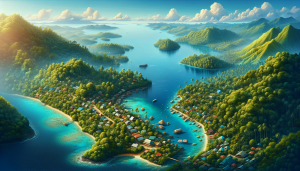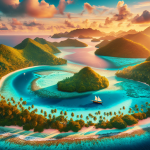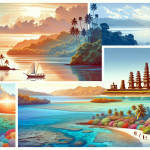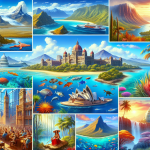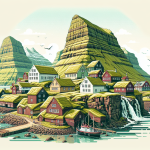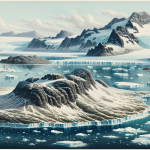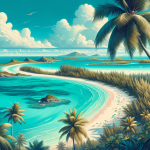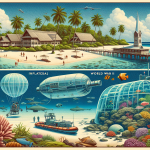Discover the Untouched Beauty of the Solomon Islands
The Solomon Islands, a hidden gem in the South Pacific, offer a unique travel experience unlike any other. This archipelago, comprising nearly 1,000 islands, is a paradise for adventurers, history enthusiasts, and nature lovers. The Solomon Islands boast pristine beaches, lush rainforests, vibrant coral reefs, and a rich cultural heritage. Despite its natural beauty and historical significance, this destination remains relatively untouched by mass tourism, making it an ideal location for travelers seeking an authentic and off-the-beaten-path experience. Whether you’re diving into the crystal-clear waters to explore World War II wrecks, trekking through dense jungles to discover traditional villages, or simply relaxing on a secluded beach, the Solomon Islands promise an unforgettable journey. In this comprehensive guide, we will delve into the various aspects that make the Solomon Islands a must-visit destination, from its breathtaking landscapes and diverse wildlife to its fascinating history and warm, welcoming people.
The Natural Wonders of the Solomon Islands
Pristine Beaches and Crystal-Clear Waters
The Solomon Islands are home to some of the most beautiful beaches in the world. White sandy shores, fringed with swaying palm trees, and turquoise waters create a picture-perfect setting for relaxation and adventure. Some of the must-visit beaches include:
- Mbonege Beach on Guadalcanal Island: Famous for its World War II wrecks, this beach offers excellent snorkeling and diving opportunities.
- Marovo Lagoon: Considered the world’s largest double barrier reef, Marovo Lagoon is a UNESCO World Heritage site known for its stunning marine biodiversity.
- Uepi Island Beach: A secluded paradise perfect for swimming, kayaking, and diving.
Vibrant Coral Reefs and Marine Life
The Solomon Islands are a diver’s paradise, boasting some of the most diverse marine ecosystems on the planet. The coral reefs are teeming with colorful fish, sea turtles, and other marine creatures. Notable diving spots include:
- Bonegi I and II: These famous dive sites near Honiara feature sunken Japanese transport ships from World War II, now home to a variety of marine life.
- Mary Island: Known for its pristine coral gardens and abundant fish species, Mary Island is a favorite among divers.
- Russell Islands: Offering a mix of caves, drop-offs, and wrecks, the Russell Islands provide a diverse diving experience.
Lush Rainforests and Unique Wildlife
Beyond the beaches and reefs, the Solomon Islands’ rainforests are a treasure trove of biodiversity. The islands are home to numerous endemic species of birds, insects, and plants. Nature enthusiasts can explore:
- Kolombangara Island: Famous for its volcanic cone and dense rainforest, Kolombangara offers excellent hiking and birdwatching opportunities.
- Tetepare Island: The largest uninhabited island in the South Pacific, Tetepare is a haven for wildlife and conservation efforts.
- Rennell Island: A UNESCO World Heritage site, Rennell Island’s Lake Tegano is the largest lake in the insular Pacific and a critical habitat for many bird species.
The Rich History of the Solomon Islands
World War II Relics and Historical Sites
The Solomon Islands played a crucial role during World War II, and remnants of this period can be found throughout the islands. History buffs can explore:
- Guadalcanal: The site of one of the most significant battles in the Pacific, Guadalcanal is home to numerous war memorials, museums, and relics.
- Iron Bottom Sound: Named for the many ships sunk during the war, this area is a popular diving spot for exploring underwater wrecks.
- Vilu War Museum: Located near Honiara, this open-air museum showcases an impressive collection of WWII artifacts, including aircraft and artillery.
Traditional Villages and Cultural Heritage
The Solomon Islands are steeped in cultural traditions that have been passed down through generations. Visitors can immerse themselves in the local way of life by visiting traditional villages and participating in cultural activities, such as:
- Visiting a Traditional Village: Many villages welcome tourists to experience their customs, dances, and crafts. Some notable villages include Owaraha (Santa Ana) and Saeraghi.
- Attending a Cultural Festival: Events like the Solomon Islands Arts Festival and the Wogasia Spear Festival offer a unique insight into the islands’ cultural heritage.
- Learning Traditional Crafts: From wood carving to basket weaving, visitors can learn about the intricate crafts that play a vital role in the local economy and culture.
Adventure Activities in the Solomon Islands
Diving and Snorkeling
The Solomon Islands are renowned for their world-class diving and snorkeling experiences. Whether you’re an experienced diver or a beginner, there are plenty of options to explore the underwater wonders. Popular activities include:
- Exploring WWII Wrecks: Dive sites like Bonegi I and II, as well as the wreck of the USS Aaron Ward, offer a fascinating glimpse into history.
- Diving in Marine Reserves: Sites like the Marovo Lagoon and the Solomon Islands’ numerous marine parks provide opportunities to see vibrant coral reefs and diverse marine life.
- Snorkeling Tours: Many islands offer guided snorkeling tours, allowing visitors to explore shallow reefs and swim with tropical fish.
Hiking and Trekking
For those who prefer to stay on land, the Solomon Islands offer a variety of hiking and trekking opportunities. Some of the best trails include:
- Mount Popomanaseu: The highest peak in the Solomon Islands, Mount Popomanaseu on Guadalcanal Island offers challenging hikes and stunning views.
- Kolombangara Island: A trek to the summit of this volcanic island provides a rewarding experience for avid hikers.
- Rennell Island: Exploring the unique landscape of Rennell Island, including Lake Tegano, offers a chance to see rare flora and fauna.
Kayaking and Canoeing
The Solomon Islands’ many lagoons, rivers, and coastal waters provide ideal conditions for kayaking and canoeing. Popular options include:
- Marovo Lagoon: Paddle through the crystal-clear waters of this stunning lagoon, exploring its many islands and coral reefs.
- Mataniko River: A canoe trip down the Mataniko River on Guadalcanal Island offers a chance to see traditional villages and lush rainforest scenery.
- Santa Isabel Island: Known for its intricate network of waterways, Santa Isabel Island is a great destination for kayaking adventures.
Practical Information for Visiting the Solomon Islands
Getting There and Around
Traveling to the Solomon Islands requires some planning, but the journey is well worth it. Key points to consider include:
- Flights: The main international gateway is Honiara International Airport (HIR) on Guadalcanal Island. Flights are available from major cities like Brisbane, Sydney, and Auckland.
- Domestic Travel: Once in the Solomon Islands, domestic flights, boats, and ferries are the primary means of getting around. Solomon Airlines and small charter flights connect many of the islands.
Accommodation Options
From luxury resorts to budget-friendly guesthouses, the Solomon Islands offer a range of accommodation options to suit different preferences and budgets. Popular choices include:
- Eco-Resorts: Places like Uepi Island Resort and Fatboys Resort offer eco-friendly accommodations with stunning views and easy access to outdoor activities.
- Guesthouses: For a more authentic experience, consider staying in a local guesthouse, such as Agnes Gateway Hotel in Munda or Sanbis Resort on Gizo Island.
- Camping: Some islands, like Tetepare, offer basic camping facilities for those looking for a more adventurous stay.
Travel Tips and Safety
To ensure a smooth and enjoyable trip, keep the following travel tips in mind:
- Health Precautions: It’s advisable to check for any necessary vaccinations and travel health recommendations before your trip. Malaria is present in some areas, so taking preventive measures is important.
- Cultural Sensitivity: Respect local customs and traditions, and always ask for permission before taking photos of people or sacred sites.
- Local Currency: The Solomon Islands Dollar (SBD) is the local currency. It’s a good idea to carry some cash, as not all places accept credit cards.
- Safety: The Solomon Islands are generally safe for travelers, but it’s always wise to stay informed about any local advisories and take standard precautions.
Conclusion
The Solomon Islands are a true paradise for those seeking an authentic and unspoiled travel experience. With their stunning natural beauty, rich history, and warm hospitality, these islands offer something for every type of traveler. From diving into the depths of WWII history to exploring pristine rainforests and vibrant coral reefs, the Solomon Islands promise an unforgettable adventure. So pack your bags, embark on a journey to this South Pacific gem, and discover the magic of the Solomon Islands for yourself.
